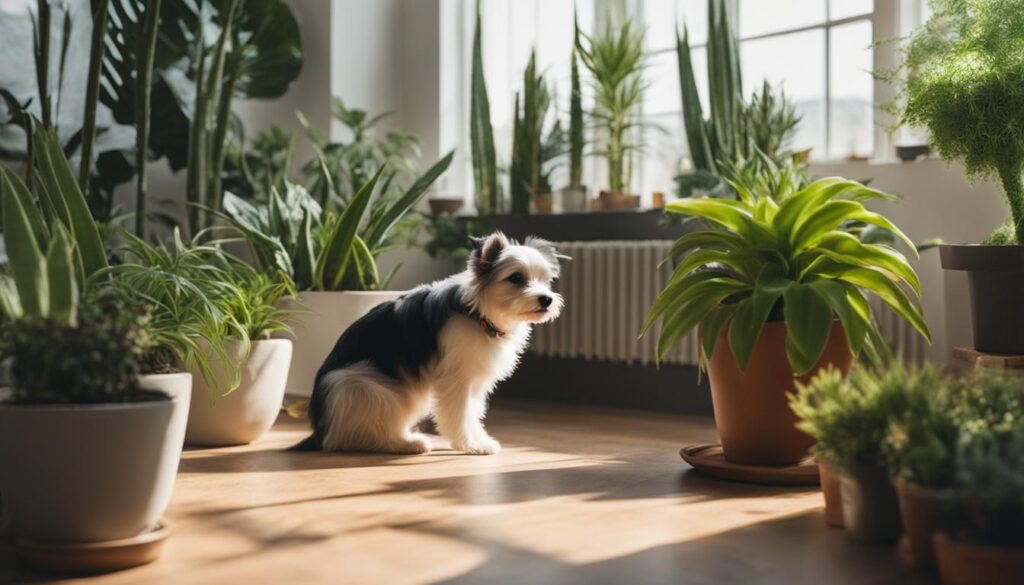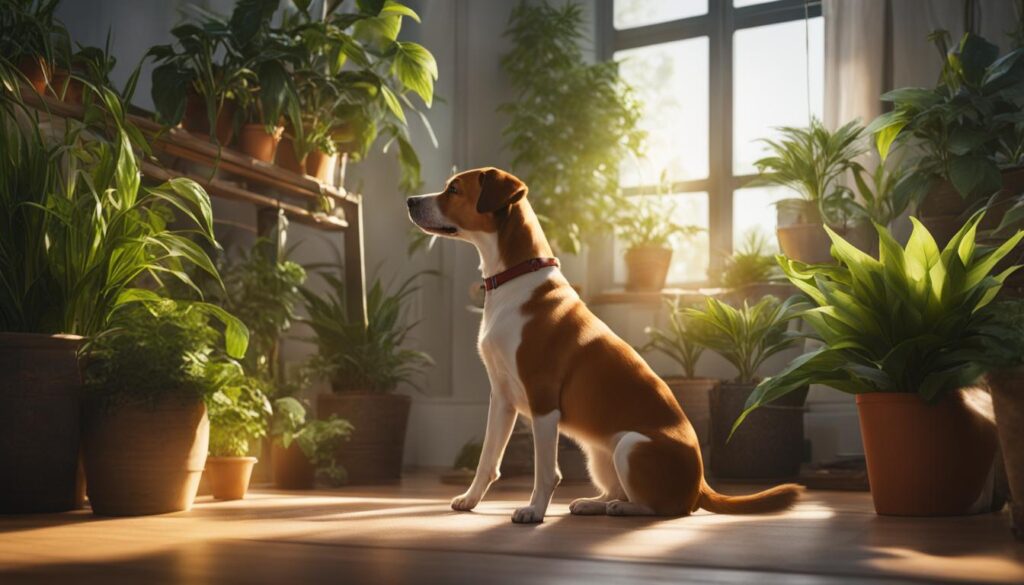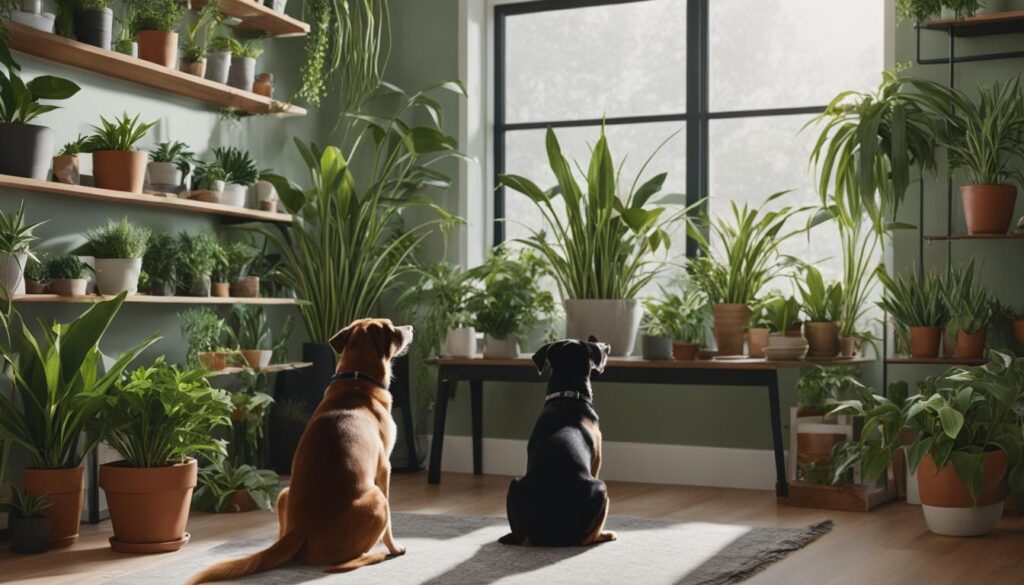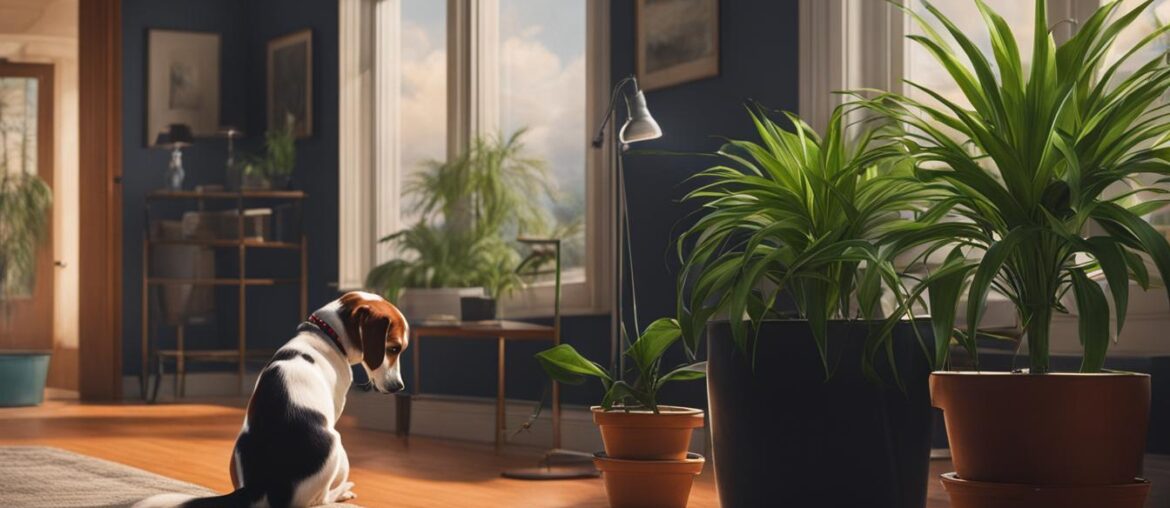As a pet owner, ensuring the safety and well-being of our furry companions is of utmost importance. One common concern that arises is whether certain indoor plants, like spider plants, pose any risks to dogs. In this article, I will explore the relationship between spider plants and dogs, shedding light on whether spider plants are poisonous to dogs and the potential dangers they may pose.
Key Takeaways:
- Spider plants, scientifically known as Chlorophytum comosum, are non-toxic to dogs, according to the ASPCA.
- Ingesting or chewing on spider plants is unlikely to cause significant harm to dogs.
- It’s essential to monitor your dog’s behavior around all plants and seek veterinary advice if any unusual symptoms occur.
- There are several safe houseplants for dogs, including Boston Ferns, Maidenhair Ferns, and Peacock Plants.
- It’s crucial to be aware of common houseplants that are toxic to dogs, such as Fiddle Leaf Figs, Pothos, Philodendrons, and Easter Lilies.
The Importance of Pet-Friendly Houseplants

Having pet-friendly houseplants is vital for ensuring the safety and well-being of our beloved dogs. By opting for dog-friendly indoor plants, we create a secure environment where our furry friends can freely roam and explore without the risk of toxic plant exposure. Not only do pet-friendly houseplants enhance the aesthetics of our homes, but they also contribute to improved air quality by filtering out harmful toxins and releasing oxygen.
One popular pet-safe option is spider plants, which add a touch of greenery and freshness to any space. However, it’s essential to be aware that there are common houseplants, such as pothos and lilies, that can be hazardous to dogs if ingested.
To ensure the well-being of our dogs, it’s crucial to become familiar with safe plants for dogs and take preventative measures to keep our pets away from any potentially harmful varieties, such as spider plants.
The Benefits of Pet-Friendly Houseplants
Pet-friendly houseplants offer numerous advantages, beyond just pet safety. Here are a few reasons why incorporating indoor plants into our homes can be beneficial for our dogs:
- Purifying the air: Certain houseplants act as natural air purifiers, removing toxins and enhancing the overall air quality. This can promote healthier respiratory function for both humans and dogs.
- Creating a soothing environment: Indoor plants have a calming effect on dogs, providing a peaceful and natural ambiance in our homes. This can help reduce anxiety and stress in our furry companions.
- Stimulating mental engagement: Some dogs enjoy interacting with certain plants, sniffing and exploring their surroundings. This interaction promotes mental stimulation and enriches their daily lives.
Choosing Pet-Friendly Houseplants
When selecting pet-friendly houseplants, it’s essential to consider factors such as toxicity levels, ease of care, and your dog’s behavior and preferences. Here are some tips for choosing the right plants:
- Research pet-safe plants: Familiarize yourself with a list of safe plants for dogs to ensure you make the best choices for your home. Consider consulting with a local nursery or your veterinarian for expert guidance.
- Ensure safe access: Keep plants out of your dog’s reach by placing them on elevated surfaces, using hanging baskets, or utilizing pet-proof shelving units. This helps prevent accidental ingestion or damage to the plants.
- Experiment with textures: Dogs have varying preferences when it comes to plants. Some might enjoy softer foliage, while others are fascinated by plants with a rougher texture. Observe your dog’s behavior and cater to their interests.
By creating a safe and engaging environment with pet-friendly houseplants, we can provide our dogs with a harmonious living space that promotes their well-being, while also enjoying the beauty and benefits of indoor greenery.
| Safe Houseplants for Dogs | Unsafe Houseplants for Dogs |
|---|---|
| Boston Ferns | Fiddle Leaf Fig |
| Maidenhair Ferns | Pothos |
| Peacock Plants | Philodendron |
| Spider Plants | Easter Lilies |
Safe Houseplants for Dogs

When it comes to choosing houseplants for your home, it’s crucial to consider the safety of your furry companions. Fortunately, there are several pet-friendly plants that are non-toxic to dogs. In addition to spider plants, there are a few other options that can add a touch of greenery to your indoor space without compromising your dog’s well-being. Let’s explore some safe houseplants for dogs:
Boston Ferns
Boston Ferns are not only visually appealing but also safe for dogs. These lush plants have soft, delicate fronds that can add a touch of elegance to any room. Boston Ferns thrive in bright, indirect light and high humidity, making them a perfect choice for bathroom or kitchen areas. Remember to keep the soil consistently moist and mist the fronds regularly to maintain their vibrant green color.
Maidenhair Ferns
Maidenhair Ferns are known for their delicate, feathery foliage and are a popular choice for indoor gardening enthusiasts. These ferns are safe for dogs and can be a beautiful addition to any room. Maidenhair Ferns prefer bright, filtered light and consistently moist soil. Be sure to place them away from direct sunlight and drafts to avoid drying out their delicate fronds.
Peacock Plants
Peacock Plants, also known as Calathea Makoyana, are prized for their striking foliage with intricate patterns resembling a peacock’s feathers. These plants are not only visually captivating but also safe for dogs. Peacock Plants prefer bright, indirect light and well-draining soil. Keep the soil evenly moist and avoid overwatering to prevent root rot. With proper care, these plants can thrive and create a stunning focal point in your home.
When introducing any new houseplant to your home, it’s important to monitor your dog’s behavior and ensure they don’t show any interest in chewing or ingesting the plants. Additionally, consider placing the plants in areas that are less accessible to your dog to prevent any accidents.
By choosing safe houseplants like Boston Ferns, Maidenhair Ferns, and Peacock Plants, you can create a pet-friendly environment that allows your dogs and indoor greenery to coexist harmoniously.
Remember to always do your research and consult with your veterinarian if you have any concerns about specific plants and their potential effects on your furry friends. With the right choices and precautions, you can enjoy the beauty of houseplants while keeping your dogs safe and happy.
Common Houseplants Toxic to Dogs

While spider plants are not toxic to dogs, it’s important to be aware of other common houseplants that can pose risks to our pets’ health. These toxic houseplants for dogs can cause various health issues, from gastrointestinal irritation to kidney failure. It’s crucial to prevent our dogs from accessing these poisonous houseplants and ensure their safety.
Examples of Toxic Houseplants for Dogs:
- Fiddle Leaf Fig
- Pothos
- Philodendron
- Easter Lilies
These plants can cause gastrointestinal irritation, leading to symptoms such as vomiting and diarrhea. They may also cause skin irritation if contact occurs. In severe cases, ingestion of these toxic houseplants can result in kidney failure. To protect our furry friends, it’s vital to keep these poisonous houseplants out of their reach and opt for pet-friendly alternatives.
Always consult your veterinarian if you suspect your dog has ingested any toxic plants or if you notice any unusual symptoms. Prompt medical attention is crucial in ensuring the health and well-being of our beloved pets.
Potential Symptoms of Plant Toxicity in Dogs

If a dog ingests a toxic plant, they may exhibit various symptoms indicative of plant toxicity. It’s important to be aware of these signs so that prompt action can be taken to address the situation. Some common symptoms of plant poisoning in dogs include:
- Nausea and vomiting
- Drooling and excessive salivation
- Gagging or choking
- Diarrhea
- Depression and lethargy
- Weakness and lack of coordination
- Abdominal discomfort
- Enlarged pupils
- Rapid breathing
- Elevated heart rate
If you notice any of these symptoms in your dog and suspect plant toxicity, it’s crucial to contact your veterinarian immediately for further guidance and treatment. Timely intervention can significantly increase the chances of a positive outcome for your beloved pet.
Emergency Actions for Plant Poisoning in Dogs
If your dog has ingested a toxic plant or is showing severe symptoms of plant poisoning, it’s crucial to take immediate action.
Contact your veterinarian or a poison control hotline for pets, such as the ASPCA Animal Poison Control Center, at 888-426-4435. It’s important to have accurate information on hand, so consider having a picture of the plant that your dog ingested available to show the veterinarian.
Your veterinarian or the poison control hotline will provide guidance on the next steps to take. In some cases, they may advise inducing vomiting at home or instruct you to bring your dog to the veterinarian’s office immediately for further examination and treatment.
Remember that every minute counts when dealing with plant poisoning in dogs, so do not hesitate to seek professional help as soon as possible.
Note: The image above is for illustrative purposes only and does not represent a specific toxic plant. Always consult a veterinarian for accurate advice and treatment.
Tips for Pet-Proofing Your Home with Plants
To ensure that your dog stays safe around plants, it’s essential to pet-proof your home. Here are some helpful tips for pet-proofing your home with plants:
- Place plants out of your dog’s reach: Keep plants on high shelves or in areas that your dog cannot access.
- Use elevated plant stands or shelves: Elevating your plants will prevent your dog from being able to reach and potentially damage them.
- Secure plants in hanging baskets: Hanging baskets can be a great way to display your plants while keeping them safely out of your dog’s reach.
- Create designated play areas: Set up specific areas in your home where your dog can play and roam freely without access to your plants.
- Use pet-safe deterrent sprays: Consider using sprays or repellents that are safe for pets to discourage your dog from approaching the plants.
- Install barriers: If necessary, use barriers or baby gates to create physical boundaries between your dog and the plants.
By implementing these tips, you can create a pet-friendly environment where your dog can coexist safely with your beloved houseplants.
Benefits of Indoor Plants for Dogs

Indoor plants can bring numerous benefits to our furry friends. They not only enhance the aesthetics of our homes but also contribute to the overall well-being of dogs. Let’s explore the positive effects of having indoor plants around our canine companions:
-
Improved Air Quality:
Indoor plants play a vital role in purifying the air by absorbing toxins and releasing oxygen. This helps to create a healthier living environment for both dogs and humans. Cleaner air can contribute to better respiratory health for dogs, reducing the risk of respiratory issues and allergies. -
Calming and Stress-Reducing:
The presence of indoor plants can have a calming effect on dogs. The touch of nature in our homes helps to create a soothing atmosphere, which promotes relaxation and reduces stress for dogs. This is particularly beneficial for dogs who may experience anxiety or separation-related issues. -
Mental Stimulation and Enrichment:
Some dogs may enjoy interacting with certain plants, providing mental stimulation and enrichment. Exploring and observing plants can awaken their natural curiosity and provide a source of entertainment. It can also serve as a healthy diversion, keeping them engaged and preventing boredom-induced behaviors.
While indoor plants offer these benefits, it’s essential to ensure that the plants are safe for your dog. Some plants may be toxic and pose risks to their health if ingested. Always research and choose pet-friendly houseplants to ensure the well-being of your furry friend.
| Benefits of Indoor Plants for Dogs | Key Points |
|---|---|
| Improved Air Quality | Indoor plants absorb toxins and release oxygen, creating a healthier environment for dogs. |
| Calming and Stress-Reducing | The presence of indoor plants can have a calming effect on dogs, reducing stress and anxiety. |
| Mental Stimulation and Enrichment | Interacting with plants can provide dogs with mental stimulation and prevent boredom. |
Choosing Pet-Friendly Houseplants

When it comes to creating a pet-friendly indoor garden, selecting the right houseplants is crucial. By considering factors such as toxicity level, ease of care, and your dog’s behavior and preferences, you can ensure a safe and harmonious environment for both your furry friend and your greenery.
First and foremost, opt for plants that are known to be non-toxic and safe for dogs. This will eliminate the risk of accidental ingestion and potential harm to your pet. Plants like Boston Ferns, Maidenhair Ferns, and Peacock Plants are great options as they are recognized as safe by organizations like the ASPCA.
Additionally, it’s important to choose plants that are not easily accessible to your dog, especially if your pup has a tendency to chew on plants. Consider placing your houseplants on elevated stands or shelves, securing them in hanging baskets, or creating designated play areas for your dog that are separate from your plants.
Furthermore, researching the specific care requirements of each plant is essential for their well-being. Some plants may have specific temperature, light, or watering needs that must be met to keep them thriving. By understanding and meeting these requirements, you can ensure that your plants and your dog coexist happily in your home.
“A dog-friendly indoor garden starts with conscientious plant selection and placement.” – PetSafe
My Pet-Friendly Houseplant Selection
Here’s a list of pet-friendly houseplants that you can consider for your indoor garden:
- Boston Fern
- Maidenhair Fern
- Peacock Plant
- Spider Plant
- Areca Palm
| Houseplant | Toxicity Level | Level of Care |
|---|---|---|
| Boston Fern | Non-toxic | Moderate |
| Maidenhair Fern | Non-toxic | Moderate |
| Peacock Plant | Non-toxic | Easy |
| Spider Plant | Non-toxic | Easy |
| Areca Palm | Non-toxic | Easy |
Remember, creating a safe and pet-friendly space for your dog is as important as nurturing your houseplants. By choosing pet-friendly houseplants, placing them strategically, and providing proper care, you can enjoy the benefits of indoor gardening while keeping your furry friend healthy and happy.
Wrapping Up
In conclusion, spider plants are not poisonous to dogs. They are considered safe and non-toxic for our furry friends.
However, it’s important to be aware of other common houseplants that can be toxic and pose risks to dogs. Some examples include Fiddle Leaf Fig, Pothos, Philodendron, and Easter Lilies. These plants can cause gastrointestinal irritation, skin irritation, vomiting, diarrhea, and in severe cases, kidney failure. Therefore, it’s crucial to keep these toxic plants out of reach of our dogs.
By choosing pet-friendly houseplants like spider plants and taking the necessary precautions to pet-proof our homes, we can create a harmonious environment where both dogs and plants can thrive. This includes placing plants out of our dog’s reach, using elevated plant stands or shelves, securing plants in hanging baskets, and creating designated play areas to keep our dogs away from the plants.
If you have any concerns about your dog’s interaction with plants or suspect plant toxicity, it’s always best to consult your veterinarian for professional advice. They can provide guidance on plant safety, symptoms to watch for, and appropriate actions to take if your dog ingests a toxic plant. Remember, your veterinarian is the best source of information when it comes to your dog’s health and well-being.
FAQ
Are spider plants poisonous to dogs?
No, spider plants are considered non-toxic to dogs.
What are pet-friendly houseplants?
Pet-friendly houseplants are indoor plants that are safe for dogs and do not pose any significant risks if ingested.
Which houseplants are safe for dogs?
Some safe houseplants for dogs include Boston Ferns, Maidenhair Ferns, and Peacock Plants.
What are some common houseplants that are toxic to dogs?
Some common houseplants that are toxic to dogs include Fiddle Leaf Fig, Pothos, Philodendron, and Easter Lilies.
What are the symptoms of plant toxicity in dogs?
Symptoms of plant toxicity in dogs can include nausea, drooling, vomiting, diarrhea, depression, weakness, lack of coordination, and more.
What should I do if my dog ingests a toxic plant?
If your dog ingests a toxic plant, contact your veterinarian or a poison control hotline for pets for further guidance and treatment.
How can I pet-proof my home with plants?
You can pet-proof your home with plants by placing them out of your dog’s reach, using elevated plant stands or shelves, securing plants in hanging baskets, and creating designated play areas for your dog to keep them away from the plants.
What are the benefits of indoor plants for dogs?
Indoor plants help to improve air quality, create a calming environment, and provide mental stimulation and enrichment for dogs.
How do I choose pet-friendly houseplants?
When choosing pet-friendly houseplants, consider their toxicity level, ease of care, and your dog’s behavior and preferences.
Is it safe for dogs to interact with houseplants?
It can be safe for dogs to interact with certain houseplants, as long as the plants are non-toxic and safe for dogs to chew on or ingest.






